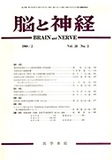Japanese
English
- 有料閲覧
- Abstract 文献概要
- 1ページ目 Look Inside
I.緒言
近年脳外科の分野において,定位脳手術はいちじるしく発達し広く行なわれるようになつている。Horsley,Clark15)により考按され, Spiegel, Wycis44)により始めて人体に応用された本手術法は,人の不随意運動症,頑痛症,てんかんなどの治療に目ざましい効果をあげている。同時にこれまで臨床症状,手術所見,および剖検からしかうかがい得なかつた人の視床を始めとする間脳の諸構造の機能を知るうえにおいて,大きな貢献をなしている。本法で目標点の決定のために基礎となるものは,気脳写あるいは空気脳室写により得られた解剖学的計測値であるが,同時に目標点の電気刺激を行なって,その部位の神経生理学的反応を見ることは欠くべからざる方法である。このような観点から定位脳手術時に間脳のいろいろな部分の電気刺激が行なわれ,その反応について多くの観察がなされている。これらの反応は運動,知覚あるいはEEGに関するものが多いが,自律神経系に関する反応もまたしばしば現われる。人の自律神経系の末梢機構は比較的良く解明されているが,その中枢調節機構については不明な点が多い。私は定位脳手術時に,これら自律神経系の反応について種々観察を行なつてきたが,本論文では脳弓手術時の反応を中心に観察結果を述べる。
The author carried out 200 cases of sterotactic brain surgery and observed various responses of autonomic nervous system. The cases include 105 cases of parkinsonism, 42 cases of intractable pain, 15 cases of psychomotor epilepsy and other miscellaneous disorders. The operating procedure was done under local anesthesia and was usually separated from PEG. General anesthesia was used in a few cases.
In fornicotomy, the amplitude of finger plethys-mogram changed remarkably. On stimulation fin-ger plethysmogram decreased in amplitude ranging from 10 to 50% in 5 of 13 cases, increased in 4 of 13 and other 4 cases showed no change. On co-agulation the plethysmogram increased in amplitude in 9 of 13 cases, decreased in 1 of 13 and other 3 cases showed no change. The maximum increase of the amplitude reached about 5 to 6 times to the pre-operative level. These plethysmographic changes were seen on both sides of the body. Fall in rectal temperature was also observed in 4 of 9 cases in fornicotomy. In the most remarkable case the rec-tal temperature decreased down from 36.8℃ pre-operative to 34.9℃ post-operative temperature and it took 4 hours before the temperature recovered to the pre-operative level. In this case finger ple-thysmogram remarkably increased in amplitude and perspiration associated with flushing of the whole body was observed. Other 3 cases showed 0.3 to 0.7℃ fall in rectal temperature. Respiratory changes and pulse rate changes were observed in a few cases. Mydriasis was seen in 6 of 15 cases (40%) on fornix stimulation.
In VL, CM and DM thalamotomy and in palli-dotomy, the autcnomic responses mentioned above were seldom obtained except that mydriasis was observed in 84% bilaterally on VL stimulation.
These autonomic responses were less frequently observed in general anesthesia cases than in local anesthesia cases. Some mechanisms caused the finger plethysmographic changes, some problems of the current spread and the localization of lesions were discussed.

Copyright © 1968, Igaku-Shoin Ltd. All rights reserved.


